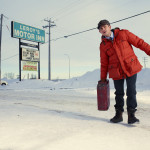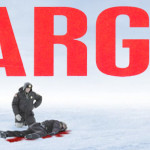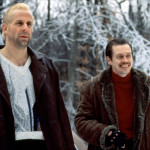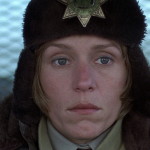I wanted to hate Fargo, the TV series, – or at least I postponed seeing it for as long as I could possibly get away with, in spite of the glittering array of awards it has garnered at the Emmys and the Golden Globes.
What possible reason could I have for that, I hear you saying to yourself. Simply that I loved the original Coen Brothers movie and felt that anything diluting or detracting from that memory would be utter sacrilege! Fargo the movie is a quirky, slow-moving snow blown film noir, set in but mostly around the snowy rural town of Fargo, North Dakota and laced with dark humour and gloriously rich characters.
The cast went to town: Frances McDormand (AKA Mrs Joel Coen) justly won an Oscar for her portrayal of the very pregnant police chief Marge Gunderson; Jerry Lundegaard, a failed used car salesman desperate for money, is played with little short of comic genius by the fabulous William H Macy; Steve Buscemi and Peter Stormare play a double act of truly dumb criminals (AKA Carl Showalter and Gaear Grimsrud), hired to kidnap Lundegaard’s wife; and so it goes on. This is a beautifully observed and devised comic crime drama that justifies its billing as a masterpiece. Oh, and the biggest joke is that this story is claimed to be based on a true story in the same way the original movie did. This from Wikipedia’s entry on the movie:
Fargo opens with the following text:
“THIS IS A TRUE STORY. The events depicted in this film took place in Minnesota in 1987. At the request of the survivors, the names have been changed. Out of respect for the dead, the rest has been told exactly as it occurred.”
Although the film plot is completely fictional, the Coen brothers claimed that many of the events that take place in the movie were actually based on true events from other cases that they threw together to make one story. Joel Coen noted:
“We weren’t interested in that kind of fidelity. The basic events are the same as in the real case, but the characterizations are fully imagined … If an audience believes that something’s based on a real event, it gives you permission to do things they might otherwise not accept.”
Why then would you want to convert it to a TV series, and how would you go about it? After all, TV’s reputation with adapting movies is variable. For every MASH and Odd Couple there are hundreds of dismal failures – this link will give you an idea of what I mean. The opportunities to crash and burn are limitless.
Let me tell you why I thought this one was going to destroy the whole Fargo concept, starting with the fact that this was the work of Noah Hawley, albeit with the Coens among the Executive Producers. It’s not that I have anything against Mr Hawley, other than that he had not made anything I’d previously heard of, nor anything particularly of note. Was he really the man for the job? Should Joel and Ethan not have handled the TV series themselves, since anything David Lynch can do they would surely be able to match?
So let’s give him the benefit of the doubt and continue. What is the monster that has he created? Series 1 is set in snowy Bemidji, Minnesota, and follows a set of none-too-bright characters engaged in a murderous series of cat-and-mouse games in what is quite plainly almost a direct copy of the original blueprint.
Oh look, there is Deputy Molly Solverson (Allison Tolman), a dead ringer for Marge; Martin Freeman (that’s right – Bilbo Baggins from the Hobbit franchise) plays Lester Nygaard (lots of these Scandinavian names around small town America, don’t you think?), plagiarised from Jerry Lundegaard down to the last nervous tic and double A; the two dumb bad guys aren’t far behind – here known as Mr Numbers (Adam Goldberg) and really deaf-dumb Mr Wrench (deaf actor Russell Harvard.)
Seems a disaster in the making, don’t you think? The Guardian also thought it would be destroyed, but were mercifully delighted (see here.) Truth be told, so was I – in fact, I leapt from scepticism to joy comfortably within episode 1 of 10. I was wrong – this is not a copy but a homage to the original, and a brilliant one at that.
The first reason to be cheerful is that the principle antagonist in this quirky adventure is Lorne Malvo, a drifter with a violent and deceptive nature who passes through Bemidji, played by Billy Bob Thornton. Thornton is among the most charismatic actors you will find anywhere. Here Malvo spends a long of time on screen neither saying nor doing anything, but you can’t take your eyes off him. More than that – in spite of a deadpan face, this is an assassin with a sense of humour, and that is worth a million straight guy killers. I can’t imagine anyone doing a finer job, one reason among many for Fargo to be awarded the Emmy for Outstanding Casting.
Reasons 2, 3 & 4: Freeman, despite being or maybe because he is British, brings exactly the right note of bumbling incompetence to the role of Nygaard, plus a full spectrum of nervous mannerisms that could keep a psychotherapist busy for years. It’s the sort of acting that has you cringing at the social ineptitude while laughing in recognition. Surely we all know a Lester Nygaard? In fact, the relative stupidity of so many of the characters is a recurring feature of Fargo.
By contrast, Tolman’s Solverson is the sharpest needle in the Fargo box, far more so than her new boss. Tolman not only does the McDormand role to a tee but adds value by virtue of being fresh and intuitive in a hugely watchable performance.
And while we’re on the excellent casting, the cameo performances are uniformly excellent, with my personal favourite being Oliver Platt‘s supermarket king Stavros Milos, who is being . Platt is another fine character actor who is rarely if ever less than excellent – an unsung hero of the movie biz, here gracing our TVs as a self-absorbed character with endless reserves of vanity. Another character leaping at the chance of glory is Tom Hanks’s son Colin Hanks as a slightly dim-witted but good-hearted cop rejoicing in the name of Gus Grimley.
Reason 5: Hawley’s script is spot on. It captures the dysfunctional surrealism of Coenworld, the absurdist scenarios, the desperation instilled in characters, the bizarre reactions inspired and the sly black ironic humour.
Reason 6: The story and mis-en-scene mirrors the original for noirish intent. However much of this story is true (it begins with the same claim to factual status as the movie), it has many the benefit of being entertaining, including as it does a situation reminiscent of Strangers on a Train, yet another bungled blackmail, a domestic murder with a strange twist – in fact, something peculiar and grotesque can be found in every episode, making each one a gem – and set against the same permafrost found in the original. Along the way there is much intrigue, characters slowly going back over the plot to figure out the truth, and bounce off each other like billiard balls.
Reason 7: The series is visually entertaining and inventive. There are many examples, but the one that amused me is when the assassin goes to Fargo to take out the group that hired two other assassins to take him out. This is filmed from the silvered outside of the building, but follows the course of his journey inside, including bursts of machine gun fire, dying groans, and ultimately one victim flying through the window to the sidewalk below. Delicious!
Season 2 continues in much the same surreal vein, except in another location with a different set of characters, but the Fargo brand remains intact. I suspect this one will run and run, by virtue of having got the basics so right. So long as its heart remains in the wrong place, it will win our hearts. A joy to watch!













